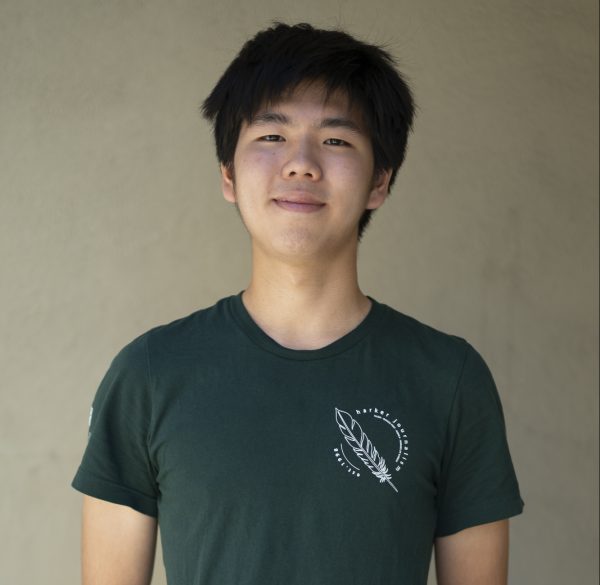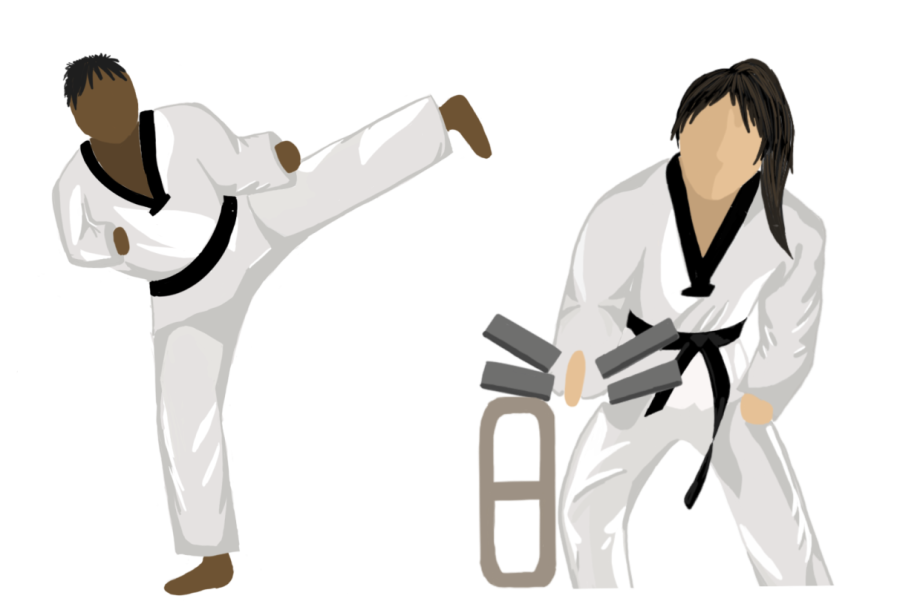Student to sensei: Mastering the art of self-defense
An illustration of two martial arts students with one performing a kick and the other breaking bricks. “Taekwondo has taught me to be disciplined, dedicated and confident in all I do,” martial artist Anika Pallapothu (10) said.
Adrenaline coursing through her veins, Chloe Lee (11) stands with one cloth-wrapped hand, facing three concrete bricks. The slabs stared back at her, the final obstacle between her and the ultimate achievement: a fourth-degree black belt in taekwondo. With a sharp twist, she struck the blocks. Before they hit the ground, she knew she had accomplished her goal.
Chloe started training in first grade at her mother’s request, who viewed the sport as a way for Chloe to both come out of her shell and connect with her Korean culture. Taekwondo originated in Korea and evolved primarily in the 1940s and 1950s, when it blended traditional Korean martial arts like taekkyeon with foreign influences, like karate. After practicing for nearly a decade and assuming an assistant teacher position at her studio, Chloe attributes her leadership skills to her invaluable experiences in the sport.
“Being an assistant teacher in my studio helped me to be as clear as possible when explaining something [and] having the leadership to teach a group of younger kids,” Chloe said. “If some of them don’t really pay attention, I would have to have that authority [and] initiative to get them to pay attention and teach them. That’s a crucial skill to have in my daily life.”
Arjun Gurjar (11) has also studied a variety of martial arts for many years. Martial arts first sparked Arjun’s interest when he watched the famed martial artist Bruce Lee in movies as a child. Now, he holds a third-degree black belt in karate, a centuries-old Okinawan sport, and he simultaneously trains in taekwondo and kickboxing, which combines aspects of karate with contemporary Western boxing. Similarly to Chloe, Arjun has become an instructor in his expertise and highlights teaching as one of his favorite parts of martial arts.
“It’s been rewarding to go from being a student to a teacher,” Arjun said. “I really enjoyed that process — that was one of the best things that’s happened to me doing martial arts. I wanted to give back, because the teachers [at my studio] dedicated [so much] to us.”
Although Arjun has achieved high levels in the sport, he continues to train hard and learn new techniques. He noted the value of the sport’s sense of community despite its seemingly solo nature.
“[Martial arts is] not so much a team sport, but you still need to have certain aspects of a team sport, like the sense of community,” Arjun said. “During practice, as you get to know each other more, you bond with your teammates.”
Anika Pallapothu (10), who trained in taekwondo for 12 years and has a fourth-degree black belt, describes how the taekwondo community enforces tenets of self-discipline. She recalls learning these ideals each day in training from a young age.
“Taekwondo has taught me to be disciplined, dedicated and confident in all I do,” Anika said. “[The community] instills [those] basic beliefs [of discipline] from when we’re a white belt all the way to our black belt testings. [Those] concepts and rules have stayed with me throughout my life, [and] have helped me outside of taekwondo as well.”
To be successful in martial arts of any kind requires hard work and discipline, from late nights spent studying forms and memorizing terms to summoning the mental fortitude to break board after board under pressure. Despite its rigorous nature, Anika explains that with enough dedication, martial arts can become an enriching hobby.
“Taekwondo may seem intimidating at the beginning,” Anika said. “If you get enough practice, and you devote enough time to learning and training different skills, it’ll become very easy and fun to do on a day-to-day basis.”

Katerina Matta (12) is an Editor-in-Chief of the Winged Post, and this is her fourth year on staff. This year, she looks forward to experimenting with...

Kevin Zhang (12) is a co-managing editor for Harker Aquila, and this is his third year on staff. This year, Kevin hopes to expand the scope of sports content...

Katelyn Zhao (12) is the co-editor-in-chief of Humans of Harker, and this is her fourth year on staff. Katelyn aims to honor each of the stories within...


















![“[Building nerf blasters] became this outlet of creativity for me that hasn't been matched by anything else. The process [of] making a build complete to your desire is such a painstakingly difficult process, but I've had to learn from [the skills needed from] soldering to proper painting. There's so many different options for everything, if you think about it, it exists. The best part is [that] if it doesn't exist, you can build it yourself," Ishaan Parate said.](https://harkeraquila.com/wp-content/uploads/2022/08/DSC_8149-900x604.jpg)




![“When I came into high school, I was ready to be a follower. But DECA was a game changer for me. It helped me overcome my fear of public speaking, and it's played such a major role in who I've become today. To be able to successfully lead a chapter of 150 students, an officer team and be one of the upperclassmen I once really admired is something I'm [really] proud of,” Anvitha Tummala ('21) said.](https://harkeraquila.com/wp-content/uploads/2021/07/Screen-Shot-2021-07-25-at-9.50.05-AM-900x594.png)







![“I think getting up in the morning and having a sense of purpose [is exciting]. I think without a certain amount of drive, life is kind of obsolete and mundane, and I think having that every single day is what makes each day unique and kind of makes life exciting,” Neymika Jain (12) said.](https://harkeraquila.com/wp-content/uploads/2017/06/Screen-Shot-2017-06-03-at-4.54.16-PM.png)








![“My slogan is ‘slow feet, don’t eat, and I’m hungry.’ You need to run fast to get where you are–you aren't going to get those championships if you aren't fast,” Angel Cervantes (12) said. “I want to do well in school on my tests and in track and win championships for my team. I live by that, [and] I can do that anywhere: in the classroom or on the field.”](https://harkeraquila.com/wp-content/uploads/2018/06/DSC5146-900x601.jpg)
![“[Volleyball has] taught me how to fall correctly, and another thing it taught is that you don’t have to be the best at something to be good at it. If you just hit the ball in a smart way, then it still scores points and you’re good at it. You could be a background player and still make a much bigger impact on the team than you would think,” Anya Gert (’20) said.](https://harkeraquila.com/wp-content/uploads/2020/06/AnnaGert_JinTuan_HoHPhotoEdited-600x900.jpeg)

![“I'm not nearly there yet, but [my confidence has] definitely been getting better since I was pretty shy and timid coming into Harker my freshman year. I know that there's a lot of people that are really confident in what they do, and I really admire them. Everyone's so driven and that has really pushed me to kind of try to find my own place in high school and be more confident,” Alyssa Huang (’20) said.](https://harkeraquila.com/wp-content/uploads/2020/06/AlyssaHuang_EmilyChen_HoHPhoto-900x749.jpeg)




